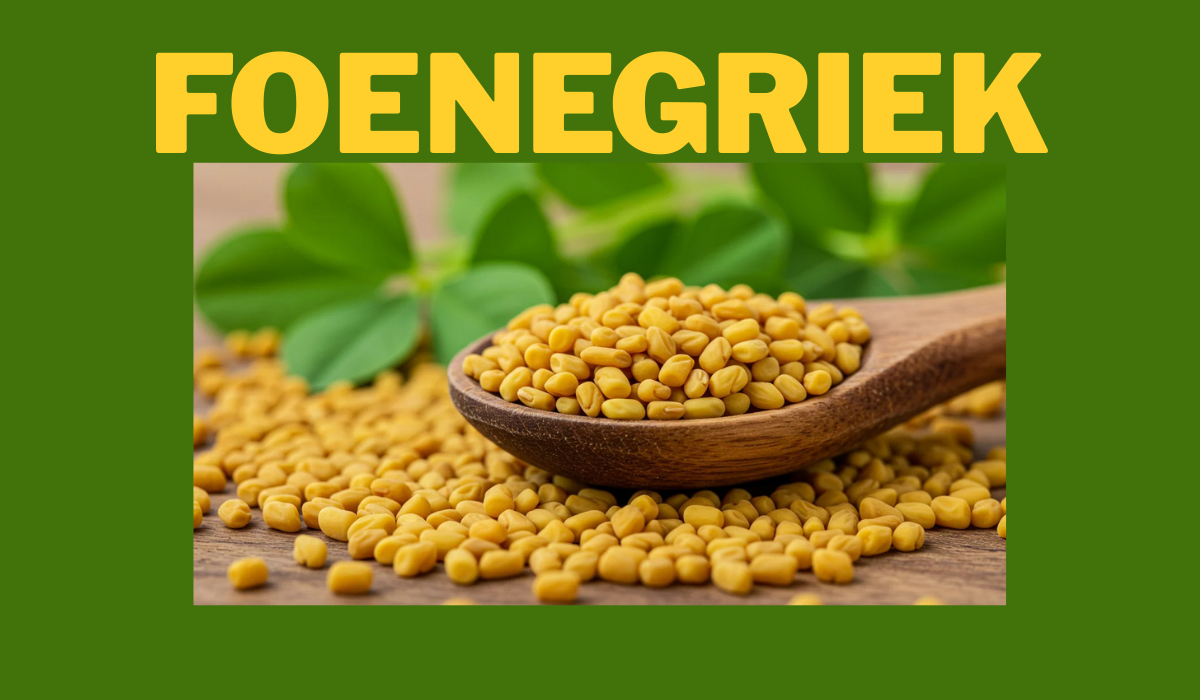The small, amber-colored seeds of the foenegriek plant have been quietly revolutionizing kitchens and medicine cabinets for over 4,000 years. Also known as fenugreek (Trigonella foenum-graecum), this remarkable herb has earned its place as one of nature’s most versatile healing foods.
From the ancient pyramids of Egypt to modern research laboratories, foenegriek continues to captivate scientists and health enthusiasts alike. Archaeological evidence shows that these distinctive seeds were found in King Tutankhamun’s tomb, while contemporary studies reveal their potential to regulate blood sugar, boost testosterone, and support lactating mothers.
But what makes foenegriek so special? Beyond its unique maple-like aroma and slightly bitter taste lies a nutritional powerhouse packed with fiber, protein, and bioactive compounds. Whether you’re looking to enhance your culinary repertoire, manage diabetes naturally, or explore traditional remedies backed by modern science, understanding foenegriek could be your gateway to better health.
This comprehensive guide explores everything from the herb’s fascinating history to practical dosage recommendations, cooking techniques, and the latest scientific research supporting its remarkable health benefits.
The Rich History and Nutritional Profile of Foenegriek
Foenegriek’s journey through human civilization reads like an adventure story spanning continents and millennia. Ancient Egyptians used these seeds for embalming and childbirth, while Greek physicians like Hippocrates prescribed them for various ailments. The Romans valued foenegriek so highly they used it as currency in some regions.
The plant itself grows as an annual herb reaching heights of two to three feet, producing distinctive three-leaflet compound leaves and small white or yellow flowers. The characteristic curved, horn-shaped pods contain 10-20 seeds each, giving the plant its Latin name “foenum-graecum,” meaning “Greek hay.”
Nutritionally, foenegriek seeds are exceptional. A single tablespoon (11.1 grams) contains approximately 35 calories, 2.5 grams of protein, 6 grams of carbohydrates, and nearly 3 grams of fiber. The seeds are rich in iron, manganese, magnesium, and copper, while also providing significant amounts of vitamin B6 and phosphorus.
What sets foenegriek apart from other herbs are its unique bioactive compounds. Saponins, particularly diosgenin, contribute to many of its hormonal effects. The seeds also contain 4-hydroxyisoleucine, an amino acid that plays a crucial role in blood sugar regulation. Trigonelline, another key compound, may support cognitive function and diabetes management.
Science-Backed Health Benefits of Foenegriek
Digestive Health and Gut Support
Foenegriek has earned recognition as a powerful digestive aid, thanks primarily to its high fiber content and mucilaginous properties. When soaked in water, the seeds form a gel-like substance that can soothe irritated digestive tract linings and promote healthy bowel movements.
Research indicates that foenegriek may help reduce symptoms of acid reflux and heartburn. The mucilage forms a protective coating along the esophagus and stomach lining, potentially reducing inflammation and discomfort. Additionally, the seeds’ prebiotic properties support beneficial gut bacteria, contributing to overall digestive wellness.
For individuals struggling with constipation, foenegriek offers a natural solution. The combination of soluble and insoluble fiber helps bulk up stool while softening it for easier passage. Traditional practitioners have long recommended foenegriek tea for digestive complaints, a practice now supported by modern understanding of its mechanisms.
Blood Sugar Regulation and Diabetes Management
Perhaps the most extensively studied benefit of foenegriek relates to blood glucose control. Multiple clinical trials demonstrate the herb’s ability to improve glycemic control in both type 1 and type 2 diabetes patients.
The amino acid 4-hydroxyisoleucine appears to enhance insulin sensitivity and stimulate glucose-dependent insulin release. This means foenegriek may help the body use insulin more effectively while only triggering insulin release when blood sugar levels are elevated.
Studies show that consuming 5-50 grams of foenegriek powder daily can significantly reduce fasting blood glucose levels and improve glucose tolerance. The soluble fiber also slows carbohydrate absorption, preventing dramatic blood sugar spikes after meals.
For pre-diabetic individuals, incorporating foenegriek into the diet may help prevent or delay the onset of type 2 diabetes. The combination of improved insulin sensitivity and slower glucose absorption creates a powerful tool for maintaining healthy blood sugar levels.
Lactation Support for Nursing Mothers
Foenegriek has gained widespread recognition as a galactagogue—a substance that promotes milk production in breastfeeding women. While the exact mechanism remains under investigation, many nursing mothers report increased milk supply within 24-72 hours of beginning supplementation.
Traditional use spans cultures worldwide, from Ayurvedic medicine in India to folk remedies in the Middle East and North Africa. Modern lactation consultants often recommend foenegriek as a first-line intervention for low milk supply, though they emphasize the importance of proper latching and frequent nursing as foundational practices.
Clinical studies support these traditional uses, with several trials showing significant increases in milk production among women taking foenegriek supplements. The typical dosage ranges from 1-6 grams of ground seeds daily, though nursing mothers should consult healthcare providers before beginning any herbal supplementation.
Testosterone and Male Health
Emerging research suggests foenegriek may offer benefits for male reproductive health, particularly regarding testosterone levels and exercise performance. Several studies indicate that foenegriek supplementation can help maintain healthy testosterone levels, especially in men over 35.
The saponins in foenegriek seeds appear to influence hormone production pathways, potentially supporting the body’s natural testosterone synthesis. Some research also suggests improvements in libido and sexual function among men taking foenegriek supplements regularly.
Athletes and fitness enthusiasts have shown interest in foenegriek for its potential to support muscle strength and recovery. Limited studies suggest that foenegriek supplementation combined with resistance training may enhance strength gains and reduce exercise-induced muscle damage.
Practical Uses of Foenegriek
Culinary Applications and Cooking Techniques
Foenegriek’s distinctive flavor profile makes it a prized ingredient in cuisines worldwide, particularly in Indian, Middle Eastern, and North African cooking. The seeds possess a complex taste combining sweetness, bitterness, and a subtle maple-like aroma that intensifies when toasted or ground.
Whole foenegriek seeds work excellently in spice blends, pickles, and slow-cooked dishes where their flavors can develop over time. Toasting the seeds in a dry pan for 1-2 minutes before grinding releases their aromatic compounds and reduces any harsh bitterness.
Ground foenegriek powder integrates easily into curries, bread dough, and spice rubs. Ethiopian berbere spice blend features foenegriek prominently, while Indian cuisine uses it in everything from dal to vegetable dishes. The powder can also be mixed into yogurt or smoothies for those seeking its health benefits without the strong flavor.
Fresh foenegriek leaves, known as methi, are considered a delicacy in many regions. These tender greens can be sautéed with onions and garlic, added to flatbreads, or incorporated into salads for a slightly bitter, spinach-like flavor.
Supplement Forms and Traditional Medicine
Modern supplement manufacturers offer foenegriek in various forms to meet different needs and preferences. Capsules provide convenience and standardized dosing, while powders offer versatility for mixing into foods and beverages.
Liquid extracts concentrate the active compounds, allowing for smaller doses while maintaining potency. Some manufacturers produce standardized extracts guaranteed to contain specific amounts of key compounds like 4-hydroxyisoleucine or saponins.
Traditional preparation methods remain popular among herbalists and home practitioners. Foenegriek tea involves steeping 1-2 teaspoons of crushed seeds in hot water for 10-15 minutes. The resulting beverage has a slightly bitter, maple-like taste that some find quite pleasant.
Soaking whole seeds overnight creates a mucilaginous drink that traditional practitioners recommend for digestive issues and blood sugar management. This preparation method preserves all the fiber and mucilage while making the seeds easier to digest.
Safety, Dosage, and Considerations
Recommended Intake Guidelines
Determining appropriate foenegriek dosage depends on individual health goals and the form being used. For general health maintenance, 1-6 grams of ground seeds daily appears safe for most adults. Those managing blood sugar may benefit from higher doses, typically 5-50 grams daily, though such amounts should be implemented under medical supervision.
Supplement manufacturers usually recommend 500-1000 mg of extract daily, equivalent to several grams of whole seeds. Starting with lower doses allows individuals to assess tolerance before increasing intake.
For nursing mothers seeking lactation support, traditional recommendations suggest 1-3 grams of ground seeds taken 2-3 times daily. Many women find success with foenegriek tea consumed throughout the day rather than concentrated doses.
Side Effects and Contraindications
While generally well-tolerated, foenegriek can cause side effects in some individuals. Gastrointestinal symptoms like bloating, gas, and diarrhea occur most commonly, especially when starting supplementation or consuming large amounts.
The herb may interact with diabetes medications by enhancing their blood sugar-lowering effects. Individuals taking insulin or other glycemic control medications should monitor blood glucose closely and work with healthcare providers when adding foenegriek to their regimen.
Pregnant women should avoid therapeutic doses of foenegriek, as the herb has traditionally been used to stimulate uterine contractions. While culinary amounts are generally considered safe, supplementation during pregnancy requires medical approval.
People with peanut or chickpea allergies may also react to foenegriek, as these plants belong to the same botanical family. Starting with small amounts allows for allergy assessment before regular use.
Choosing Quality Foenegriek Supplements
Evaluating Different Forms and Brands
The supplement market offers numerous foenegriek products with varying quality, potency, and standardization. Reputable manufacturers provide third-party testing certificates confirming purity and potency while screening for contaminants like heavy metals and pesticides.
Standardized extracts offer consistency by guaranteeing specific concentrations of active compounds. Look for products standardized to contain 50% saponins or specific amounts of 4-hydroxyisoleucine when targeting blood sugar support.
Organic certification ensures the herbs were grown without synthetic pesticides or fertilizers, while non-GMO verification confirms the plants haven’t been genetically modified. These certifications, while not necessary for efficacy, appeal to consumers prioritizing natural and sustainable products.
Capsule supplements should use vegetarian or plant-based capsules rather than gelatin for broader dietary compatibility. Powder forms offer the most versatility but require proper storage in cool, dry conditions to maintain potency.
Delicious Recipes and Culinary Inspiration
Traditional and Modern Cooking Applications
Incorporating foenegriek into daily cooking requires understanding its flavor profile and optimal preparation methods. These recipes demonstrate the herb’s versatility while providing therapeutic benefits.
Foenegriek Seed Tea serves as an excellent introduction to the herb’s benefits. Crush one tablespoon of seeds lightly, steep in boiling water for 10 minutes, then strain. Add honey and lemon to taste. This preparation supports digestion and blood sugar management.
Spiced Foenegriek Flatbread combines 2 cups flour, 1 teaspoon ground foenegriek, 1 teaspoon cumin, salt, water, and oil. Knead into soft dough, roll thin, and cook on a hot griddle. The bread pairs excellently with curries and provides sustained energy.
Maple-Foenegriek Smoothie blends 1 cup plant milk, 1 banana, 1 tablespoon ground foenegriek, 1 teaspoon maple syrup, and ice. The natural maple notes in foenegriek complement the sweetener while providing fiber and protein.
Traditional Methi Dal showcases fresh foenegriek leaves. Sauté onions, garlic, and ginger, add 1 cup lentils, 3 cups water, turmeric, and salt. Simmer until tender, then fold in chopped fresh foenegriek leaves during the final 5 minutes of cooking.
Current Research and Future Directions
Scientific Studies and Clinical Evidence
Recent research continues expanding our understanding of foenegriek’s therapeutic potential. A 2020 systematic review analyzing multiple clinical trials confirmed the herb’s effectiveness for glycemic control, with particularly strong evidence for reducing fasting blood glucose and HbA1c levels.
Cardiovascular health represents an emerging area of interest, with preliminary studies suggesting foenegriek may help reduce cholesterol levels and support heart health. The soluble fiber contributes to cholesterol reduction, while antioxidant compounds may protect against oxidative stress.
Exercise performance and muscle recovery studies show promise but require larger, longer-term trials to establish definitive benefits. Early research indicates potential improvements in strength training outcomes and reduced muscle soreness following intense exercise.
Women’s health research extends beyond lactation support to investigate foenegriek’s effects on menstrual health and menopausal symptoms. Limited studies suggest possible benefits for reducing menstrual cramps and supporting hormonal balance during perimenopause.
Areas for Future Investigation
Scientists continue investigating foenegriek’s potential applications in cognitive health, cancer prevention, and metabolic syndrome management. The herb’s complex phytochemical profile suggests multiple therapeutic targets that warrant systematic study.
Optimal dosing protocols require further research to establish clear guidelines for specific health conditions. Most existing studies use varying doses and preparations, making it challenging to provide precise recommendations.
Long-term safety data remains limited, particularly for high-dose supplementation over extended periods. While traditional use suggests general safety, comprehensive toxicology studies would provide valuable guidance for modern applications.
Embracing Foenegriek for Optimal Wellness
Foenegriek stands as a testament to the enduring wisdom of traditional medicine validated by modern scientific inquiry. From ancient Egyptian tombs to contemporary research laboratories, these humble seeds continue revealing their remarkable potential for supporting human health.
The evidence supporting foenegriek’s benefits for blood sugar management, digestive health, and lactation support provides compelling reasons to explore this versatile herb. Whether incorporated through cooking, consumed as tea, or taken in supplement form, foenegriek offers multiple pathways to enhanced wellness.
As research continues uncovering new applications and mechanisms, foenegriek’s role in preventive healthcare will likely expand. The key lies in approaching this powerful herb with respect for both its traditional uses and scientific validation, always prioritizing safety and quality in product selection.
For those ready to experience foenegriek’s benefits firsthand, start with small culinary amounts to assess tolerance, then gradually explore therapeutic applications under appropriate guidance. The journey toward better health often begins with simple steps, and foenegriek provides an excellent companion for that path.





